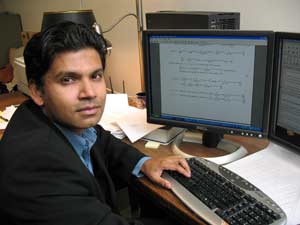|
|

|

|
 |
|
|
On What Doesn’t Meet the Eye
Physicist Studies Nature of Quantum Mechanics and the Submicroscopic World of ‘Qubits’
|

Kunal Das, Ph.D., is a theoretical physicist.
Photo by Janet Sassi
|
|
|
|
By Janet Sassi
Some people want to move mountains. Kunal Das, Ph.D., assistant professor of physics, wants to move electrons.
Das is a theoretical physicist researching an area where the classical
rules of physics no longer apply—the nanoscale universe of quantum
physics, a submicroscopic world where particles defy common sense. In
that mysterious world of the ultra-small, Das is searching for new ways
to move the currents that power computers.
“When the first computers came along in the 1960s, they were huge
objects which filled up an entire room and had miniscule computing
power,” Das says, as he gestures to his computer in his Freeman Hall
office. “How is it that today we have something this compact and with
this much more power? Today, every two years computers become twice as
fast and half as big.”
Computers are powered by electronic circuitry in which currents move
large clusters of electrons at a time to feed a tiny computer chip. The
number of electrons needed for each operation has gotten smaller with
time. But within 20 years, Das says, computers will reach a point where
each operation could be done by just one electron, and thus won’t be
able to get any faster or any smaller.
What then? Where will technology go?
Already, scientists are experimenting with storing information not in
bits, but in qubits (or quantum bits), which can potentially store much
larger amount of information than traditional bits. Can a “quantumchip”
be in the offing?
That’s where quantum mechanics come in.
Das has focused his research on adiabatic electron pumps, which can be
used to control the flow of individual or entangled pairs of electrons
in order to power quantum computers. Quantum computers, which are still
in their infancy, have the potential to perform certain calculations
significantly faster than any silicon-based computer.
Quantum mechanics have become very important partly because, at the
qubit level, individual particles of matter play essential roles. The
current that powers the computer no longer flows as a cluster of
electrons, but as one electron at a time; and such motion is governed
by quantum mechanics.
“In classical physics, we talk about currents flowing continuously,
like water,” Das says. “At the nanoscale, your current is comprised of
individual electrons, and it is discrete as opposed to continuous.”
In other words, if you were to look at water flowing through a pipe,
you would discover that at the submicroscopic level it is made of
molecules that are discrete from one another, like individual grains of
sand.
The problem is that the super-small world of quantum mechanics is
notoriously unpredictable. In fact, an electron at the quantum level
has a few weird characteristics that stem from the fact that quantum
mechanics is all about probabilities, not absolutes.
“An electron, from a quantum mechanical perspective, does not behave
like it does in classic physics, where it always acts like a particle,”
Das says. “Here, it acts like a particle some of the time and like a
wave some of the time. It has wave-particle duality, and it becomes
probabilistic, meaning you cannot say for sure that the electron is
definitely here. It might have some probability of it being here, or
some probability of it being there. That’s what makes quantum mechanics
strange and confusing to the layperson.”
An adiabatic electron pumping system is complex, but Das describes it
as a mechanism that manipulates the shape of the “quantum wavefunction”
of an electron, by varying such things as voltage or a magnetic field
at the nanoscale. Das is researching how to apply the pumping system to
single electrons and also to pairs of “entangled” electrons in which
one electron can affect another even when separated by vast distances.
He hopes that his research will ultimately lead to a dependable system
of moving currents of electrons in a precisely controlled way without
destroying their fragile quantum state, which is essential to powering
quantum computers.
“Once we start using the wave nature of electrons and the probabilistic
nature of quantum mechanics, we can potentially do certain computations
tremendously faster,” he says.
Potentially?
At this point, quantum computers have not yet been built, although some
experiments have been carried out. Research is being done at a frantic
pace, however, as such systems would be invaluable to national
security, Das says.
“All existing encryption systems are based upon the fact that we cannot
crack them with the computers that we have available now,” says Das.
“With a quantum mechanical algorithm, you could crack encryption
methods very fast.”
There are also potential applications to teleportation, Das says, but not of the Star Trek variety—at least not yet.
“
What you could teleport is the state of an electron,” he says. “We
could transfer those properties to a location which is far away, but
not the physical object itself. So, in a sense, in quantum mechanics,
you can be in two places at the same time.” |
More Top Stories in this issue:
Return to In Focus: Faculty and Research index
Return to Inside Fordham home page
Copyright © 2007, Fordham University.
|
|

|
|

